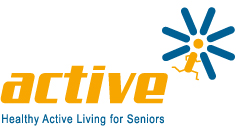| Starting physical activity |
Starting physical activityAdvantages and disadvantages of being physically active: If you are still thinking about increasing physical activities in your daily life, the following advantages may convince you to start:
Besides these advantages, physical activity is also connected to some risks:
Based on this information you will have to weigh up the risks of performing physical activity against the risks of inactivity! Adults aged 65 years and older gain substantial health benefits from regular physical activity, and these benefits continue to occur throughout the years.. (Needs Analysis Active I, p. 26, based on: ACSM, 2009; Colcombe & Kramer, 2003; Dunsky & Netz, 2012; Haskell et al., 2007; Mechling & Netz, 2009; Netz, Wu, Becker & Tennenbaum, 2005).).
Your exercise routineTo avoid injuries or cardiovascular complications, please have a look in the “safety” section and create a reasonable exercise routine. This exercise routine is composed of 3 sections:: Warm up: To activate your cardiovascular system, start with walking outside for 5-10 minutes at a speed that is comfortable for you (or in your home if the weather is bad).. The main part of the exercises: Do your planned activities (e.g. walking, balance or strength exercises) in the main part of your exercise routine.. Cool Down: You should include a cool down/stretching routine after each session. To limber up and relax your muscles after your physical activities. Training clothess A combination of sports t-shirt and long or short sport-trousers with sport shoes is the optimal training outfit for starting your physical activity. If you do not have sport clothes you can also use a comfortable shirt and loose-fitting trousers. Open shoes, slippers or sandals are not suitable.. |
| Recommendations for physical activity for health according to the World Health Organization (adapted and shortened): |
Recommendations for physical activity for health according to the World Health Organization (adapted and shortened):To promote and maintain health,
WHO (2010). Global recommendations on physical activity for health. Available online recommendations Accessed on November 25, 2013. |
| Recommendations against sedentary behavior |
Recommendations against sedentary behaviorBeside little or no physical activity sedentary behavior is also associated with disease. Sedentary behavior is activity that involves little or no movement or physical activity. Examples are sitting, watching television, playing video games, and using a computer (ACSM, 2011). There are several strategies to prevent sedentarism (Dustan, Howard, Healy, & Owen, 2012):
American College of Sports Medicine (ACSM) (2011). Quantity and quality of exercise for developing and maintaining cardiorespiratory, musculoskeletal, and neuromotor fitness in apparently healthy adults: guidance for prescribing exercise. A position stand. Medicine and Science in Sports and Exercise, 43, 1334-1359. Dunstan, D. W., Howard, B., Healy, G. N., & Owen, N. (2012). Too much sitting--a health hazard. Diabetes Research and Clinical Practice, 97, 368-376. |
| Safety |
SafetyTo participate in physical activities has many health benefits for your physical and mental health and it increases your wellbeing. To make 'being active' an enjoyable experience, we recommend that you consider the following safety tips::
|



 Watch the Plan50+ User Manual.
Watch the Plan50+ User Manual.
